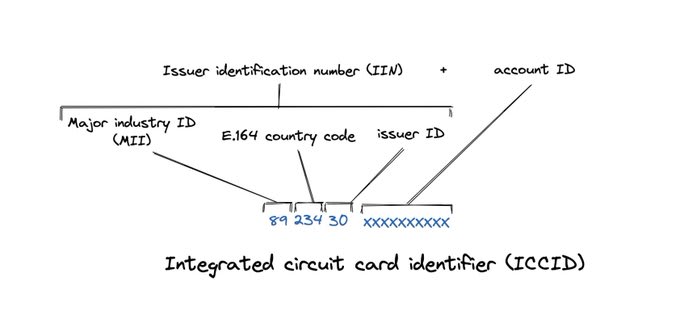This is a side effect of looking into USSD
SIM and eSIM data are equivalent.
Physical SIMs are PVCs with integrated circuits.
eSIMs are just software that store the same information.
Both are identified in the same way.
Each SIM is identified by an ICCID.
These are strings of text made up of 4 parts:
- a fixed part "89", which identifies the mobile industry
- an E.164 country code (e.g. UK is 44, Nigeria is 234)
- an identifier of the mobile network
- a mobile phone account identifier
SIMs store IMSI numbers which identify mobile phone customers.
They're made up of 3 parts:
a completely different country code, known as a mobile country code (E.212)
a mobile network identifier, often the same as the issuer ID in the ICCID
a subscriber identifier
Finally, the MSISDN (aka phone number) routes mobile networks to the IMSI.
These are made up 3 parts:
- a standard E.164 country code
- a regionally-administered code (either NDC or NPA)
- a subscriber (customer) identifier
Overall
There are lots of similarities, with some values even overlapping.
ICCID and MSISDN use E.164 country codes.
ICCID and IMSI often share the same number as Issuer ID and MNC.
ICCID and IMSI often share the same number as account ID and MSIN.








Top comments (1)
SIM cards, or Subscriber Identity Module cards, play a crucial role in connecting mobile devices to cellular networks. Essentially, activate smart sim contains unique identification information assigned to a specific user and device. When inserted into a compatible phone or tablet, the SIM card communicates with the mobile network provider, allowing the device to establish a connection. This connection enables users to make calls, send messages, and access data services. The SIM card authenticates the user's identity to the network, authorizing access to services based on the user's subscription plan and account details. Additionally, SIM cards store contacts and other user information, providing a convenient means of transferring data between devices. Overall, SIM cards serve as the bridge between mobile devices and cellular networks, facilitating seamless communication and access to services.
Some comments may only be visible to logged-in visitors. Sign in to view all comments.